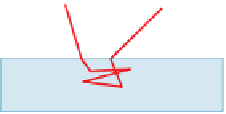Graphics Reference
In-Depth Information
outscattering: Light hitting the medium may be scattered in various directions,
causing things like the aforementioned shafts of light you see on a sunny day in a
dusty room. This outscattering may not be uniform. Typically it's assumed that the
outscattering is constant as a function of course-deviation: If the light is traveling
in direction
v
is assumed to be
, the probability of scattering to a new direction
v
v
·
v
only. The third phenomenon is inscattering (shown at the green
particle, just to the left of center in the diagram): Light scattered from other parts
of the medium may arrive at some point and scatter so as to add the light we're
already observing. (Outscattered and inscattered light are therefore analogous to
surface radiance and field radiance.)
These four effects can be combined to characterize how the radiance
L
(
P
,
afunctionof
)
v
at some point
P
in some direction
is related to the radiance at
P
+
v
in direction
v
0 gives an equation that
L
must satisfy, analogous to the rendering equation. Pharr and Humphreys [PH10]
and Rushmeier [Rus08] give a great deal more detail on this subject.
The absorption constant
; dividing the difference by
and taking a limit as
→
v
σ
has units of inverse meters. If light travels a distance
/σ
of 1
through the absorbing medium, it's attenuated by a factor of
e
. Perhaps
more intuitive is that if the light travels 2.303
/σ
, it's attenuated by a factor of 10.
Even so,
is not an intuitively easy-to-understand item. An artist is more likely
to find 2.303
σ
, the distance it takes to decrease by a factor of 10, to be a natural
control for absorption.
The coefficient of extinction,
/σ
, mentioned in Chapter 26 and sometimes used
as the imaginary part of a complex index of refraction, is closely related to the
absorption constant
κ
: It represents the exponential decay of the electromagnetic
wave as it enters a homogeneous material. If we compute the absorption constant
for the material at a particular wavelength
σ
λ
, the two are related by
=
λσ
4
κ
.
(27.43)
π
Thus, the explicit dependence of absorption on wavelength is naturally incorpo-
rated by using
. Of course, neither the idea of a complex index of refraction
nor the coefficient of extinction is likely to be readily understood by a user; once
again, the inverse of
κ
is likely to be more natural as a user control for material
design. And for a material like smoke or fog, the absorption phenomenon is not
really
being governed by index-of-refraction effects, but by larger-scale phenom-
ena, such as light entering and leaving the individual droplets of water in the fog.
κ
o
i
In addition to mirrorlike reflections (and more diffuse reflections arising frommul-
tiple microfacets) and volumetric scattering, there's a third kind of scattering that
is very common: subsurface scattering.
Q
P
In human skin, for instance, light meeting the skin at some point
P
may leave
the skin at another point
Q
. To see this, sit in a dark room facing a mirror and
place a small flashlight firmly against your cheek. You will see the skin around the
flashlight glowing red because of subsurface conduction of the light. This cannot
be modeled by a surface-based BSDF. Instead, we use a bidirectional subsurface
scattering distribution function (BSSRDF), which has the form
f
ss
(
P
,
Q
,
Figure 27.19: The arguments to
the BSSRDF. The light enters the
material at P from the source
pointed to by
v
i
, travels along
the red path, bouncing inside the
material, and exits at Q in direc-
tion
v
i
,
v
o
)
,
which represents the light leaving in direction
v
o
from the point
Q
in response to
light arriving from direction
v
i
at point
P
(see Figure 27.19). It's convenient to
v
o
.




















